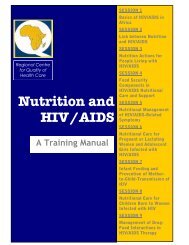2.1: Anthropometric Indicators Measurement Guide - Linkages Project
2.1: Anthropometric Indicators Measurement Guide - Linkages Project
2.1: Anthropometric Indicators Measurement Guide - Linkages Project
Create successful ePaper yourself
Turn your PDF publications into a flip-book with our unique Google optimized e-Paper software.
APPENDIX<br />
4.Measuring<br />
Adults<br />
9.<br />
The use of indicators of adult nutritional<br />
status for evaluating and monitoring<br />
USAID Title II development programs is<br />
limited. There is some experience with<br />
micronutrient status including anemia<br />
and Vitamin A and more with assessing<br />
body mass index for women. This section<br />
does not deal with obesity, micronutrient<br />
malnutrition or pregnancy. The information<br />
in this section refers to anthropometric<br />
assessment and is derived from<br />
various sources including FAO, WHO and<br />
the recent publication from the ACC/SCN<br />
available from their website:<br />
acc.unsystem.org/scn/.<br />
Adults are defined by WHO as those in<br />
the age range of 25-60 years although<br />
categories often extend from 20 years to 65<br />
years of age. Adult anthropometrics have<br />
not been standardized in terms of<br />
reference data or choice of indicators for<br />
risk and response assessment as they have<br />
been for children. As noted in various<br />
sources, there is no recommended<br />
indicator or assessment approach for adult<br />
nutritional status. The assessment of<br />
adults older than 60 years presents a<br />
number of specific challenges not covered<br />
here. The reader is referred to the work of<br />
Help Age to deal with these assessments<br />
(Ismail, S. and Manandhar, M. 1999).<br />
As with children, adult anthropometric<br />
assessment is used to reflect undernutrition.<br />
Anthropometry is also used to<br />
reflect over nutrition but this is not the<br />
focus of this guide. Undernutrition in<br />
adults is characterized by patterns of acute<br />
and chronic deficiency of energy, protein<br />
and micronutrients including vitamins<br />
and minerals. Often a person is affected<br />
by both acute and chronic deficiency in all<br />
or some of the key nutrients. The<br />
manifestation of the deficiency and the<br />
measurement is therefore, complicated to<br />
determine and the functional significance<br />
unclear. Undernutrition is characterized<br />
by a lack of food and while specific<br />
nutrient deficiencies occur, such as<br />
pellagra due to a lack of niacin, the<br />
primary cause is more general. We are<br />
learning more about specific nutrient<br />
requirements for diseases such as HIV/<br />
AIDS but the ability of anthropometrics to<br />
identify these conditions is limited.<br />
Adult anthropometric assessment is used<br />
for several purposes including:<br />
• screening or targeting individuals for<br />
some sort of intervention or action such as<br />
supplementary feeding during famine<br />
relief,<br />
• surveillance or monitoring of changes<br />
in prevalence and coverage in groups or<br />
populations to trigger a response<br />
including graduating from an intervention,<br />
• evaluating the impact of activities or<br />
interventions.<br />
Anthropometry is used to describe the<br />
nutritional situation in a population and<br />
this can be useful for problem analysis<br />
and for evaluation. Because the deter-<br />
74

















